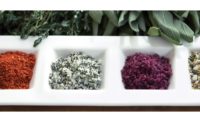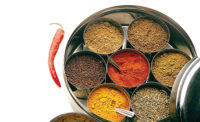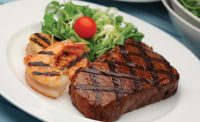Cover Story
Building up Meat and Poultry
Meat seasoning has seen a boost from dry rubs, especially those including specialty gourmet sea salts--smoked salts, herb- and spice-infused salts, and volcanic salts.


Rubs and simple marinades in heat-and-serve formulations require a fine-tuned balance of spices and pH to ensure the typically long shelf-life doesn't lead to altered flavors or textures.

Bolder, ethnic flavors have continued an upward trend, as have more rustic cuts of meat, such as ribs.





The creative uses of rubs, spices, sauces and condiments has grown, as trends move more boldly into exotic and ethnic flavors. To release flavors at their peak, some techniques work better than others, and the use of a dry or wet rub vs. a sauce or marinade depends on not just the formulation, but also its eventual use.
While flexitarianism, veganism, meat-free Mondays and other vegetarian-influenced trends have been growing, meat consumption has stayed relatively steady overall. Just look at the bacon craze that has recently taken the country by storm; crispy strips of pork belly are showing up everywhere, from popcorn to ice cream to chocolate candies.
Perhaps the greatest forward motion in seasoning meats has come from dry rubs, especially those including specialty gourmet sea salts—smoked salts, herb- and spice-infused salts, and volcanic salts. These are combined with spices, including herbs, peppers and garlic.
A good sense of ingredients is the foundation for creative uses of rubs, sauces and condiments. These are front and center in a dish, meant to enhance and enliven a finished product, making the challenge fun and precise. Add the sophisticated consumer looking for convenient, healthier products that are, at the same time, new and exciting and that translates to pure, clear, clean flavors in new combinations and applications.
The characteristics of each ingredient in a rub—whether a salt, herb, spice or other flavoring—act as a guide in the approach taken for each application. The advantage to a dry rub is that, being dried to the lowest activity of water possible, they hold up to the time and travel they must endure during the entire product cycle. One of the biggest challenges with rubs, sauces and condiments is working out combinations and formulas that remain tasty all the way to the plate.
Stripping down the formulas to their purest forms with the use of bolstering underground/background flavors can create and maintain the punch.
It also is important to think of the seasoning, regarding amounts and strength of flavors, through to the end-usage.
“When developing the seasonings for our Oven Perfect line, we had to consider the cook-in-bag technique and how it might affect the level of spices needed,” says Bert Lawson, culinary manager and research chef for Farmland Foods Inc. “In traditional methods, juices—and with them, the seasonings—often roast off, and [the final product] becomes less flavorful. Since Oven Perfect cooks with the seasonings in the bag, juices and flavors are locked in, resulting in perfectly seasoned pork in every bite. Selecting the right amount of seasoning intensity was a critical part of the development process,” continues Lawson.
Rub the Right Way
When it comes to fresh herbs, chefs know to use only the leaves; but, dried herbs, even of high quality, can often include stems. Too many, and the mix becomes “woody” and tastes more of tree bark than the intended herb.
With dried herbs, less is more. Using dried herbs in sauces and condiments works well, as there is more moisture to revive the herbs. To use in rubs, crushing to release their flavor is important, and the addition of moisture or oil in the final application can help release flavors and prevent a crunchy-dusty mouthfeel.
Being about 5-10 times as concentrated as fresh herbs, dried herbs can overpower a finished flavor. To avoid this, herb rubs are best used once the consumer brings the product home. Processors are now including dry and even wet rubs in separate packages, as a value-added seasoning proposition. Allowing the end-user to apply them in this way can help ensure that the item to marinate will not become over-seasoned, soft or mushy on the surface. This is especially true of the strong “piney” herbs, such as rosemary, oregano and thyme. These can increase in their intensity, if left for a long time in contact with food, or in a sauce, marinade or condiment.
Conversely, sweet herbs, such as tarragon, parsley, dill, basil and chervil lose their flavor quickly in cooking and are best when added at the end of cooking or right before serving. Kept in seasoning packets, the consumer has the ease of use and the flexibility to add during cooking or just before the finish, depending on the mixture. Herbs will rehydrate without losing their spunk, in either case. If using the herbs to flavor a low-moisture preparation, consumers need to revive them with a small amount of water or broth before adding to the dish.
Sizzlin’ Spice
Nothing adds a buzz and a kick in products quite as well as spices—literally the dried seeds, roots, berries, and even bark or stems of a plant. But, the flavor of spices resides in their volatile oils, which dissipate rapidly once exposed and stale quickly. In an increasingly sophisticated market full of choices and savvy buyers, flavor is paramount. If the spice is dead, so goes the dish.
Preparers should purchase whole spices and store them in light-protected containers, away from heat sources. Light is a killer of spice intensity. For continued success along the product cycle, spices benefit from being packaged in light-protected sleeves. If kept in a dark package and utilized as close to prep time as possible, the flavors will remain bold and authentic. Grind spices as close as possible to the time of mixing formulas. Also, toasting spices before grinding allows the flavors to become deeper and more intense.
Starchy spices (typically derived from roots), such as turmeric and curry blends, are best added at the beginning of cooking to rid them of their bitter, chalky taste. They need to be sautéed in a bit of oil or cooked in a liquid. When added to a spice packet, use in an application where they will be added at the beginning of the cooking phase, not as a final seasoning.
Pepper is as routine as salt, to the point that people can be desensitized to it. But, when considered botanically, the knowledge that it is a berry reveals its merit. When left whole until immediately before use, pepper reveals its innate, sweet back-notes and releases a more complete flavor profile. Pre-crushed or ground pepper causes the flavor-carrying volatile oils to fade, leaving only the heat.
Increasingly, pepper has been shown off in a sweet context. Chocolate and pepper, for example, can lead to some engaging new ideas. Other types of pepper, such as Szechuan or Comet’s Tail, have a menthol/eucalyptus undercurrent and are best if used discreetly. The end-product will be less overwhelmed by the essential oils.
Wet and Fruity
Sauces and pastes share many of the same considerations of dry flavoring systems, but they carry their own challenges. Typically, they are oil-, acid- or even tomato-based, but they can appear as simple purées and tapenades, too. Vinegar remains a popular acid medium for wet flavorants, but the acidic boost from citrus juice is a perfect choice for sauces and condiments. It adds a tang; cuts bitterness and saltiness; and complements flavors. The essential oils from citrus peel can add a powerful depth of flavor to preparations.
Pre-dried fruits and fruit peels can be bitter and suffer a loss of flavor, if they have been heat-processed. If feasible, air-dry citrus peel and give it a quick toasting, once dried. The difference is startling and long-lasting. Another option is to use freeze- or vacuum-dried products. A new method of drying fruits and vegetables is microdrying. It involves vacuum-microwave technology to preserve all aspects—flavor, color, even the nutritional components of the whole fruit—without breaking down the product or imparting any off-flavors.
Sweeteners also can behave as spice components, especially in Asian-influenced preparations. Adding sugar, brown sugar, honey, or even maple or agave in discreet amounts to some preparations pulls flavors together in much the same manner as does salt. Also, to obtain a desired tart note without using citrus, try sumac or hibiscus. These are good options for a formulation without liquid, such as a rub.
Other unconventional (but upwardly trending) ingredients that impart deep, rich, unidentifiable flavor are the ace in the hole for chefs. These are added in subtle amounts, so the gustatory experience is cumulative and impressive—the way chocolate behaves in molé sauce.
Examples include espresso powder, unsweetened cocoa, vanilla powder, smoked paprika, green tea powder, ground dried tomatoes, dried wild mushroom powder, soy, fish sauce and anchovy paste. These all add unique “underground” flavors that unify and bolster a preparation. So, too, can reductions, such as of apple cider, juices, stock, wine, spirits or stronger flavors, like balsamic vinegar or fortified wine reductions. Adding even more depth with meat glazes is an old-fashioned flavor trick currently enjoying a revival.
The Process
Scaling up is also a challenge. Preparing rubs and spice blends in volume does not always mean testing a small batch and multiplying. Exact scale-ups sometimes are too overpowering in certain flavors. When it comes to herbs and spices in rubs, testing along the way and adjusting amounts of specific ingredients will save time in the long-run. If one has the perfectly balanced chili powder formula in a small test batch, it might have to be worked up slowly, to keep the same flavor and heat level.
Ideally, rubs packaged separately produce the best end-result. However, if that is not a possibility, products such as meat or poultry need to be as dry as possible before spices are added. Flavor loss and caking in the package are a result of moisture, so cuts need to be completely dry before applying a rub. Mix the rub with a touch of oil before applying. Mixing spices with oil helps coat a piece of meat or poultry evenly and distribute good, lasting flavor, as the essential oils in spices bind with the applied oil base.
Pastes are a multi-talented product, with special advantages in frozen meat and poultry products. Frozen, pastes retain a fresh, just-made flavor. They can be used as a condiment to accompany frozen dinners; added to sauces served warm; or thawed and added to mustard, mayonnaise or dressing for a fresh-flavor boost. A paste typically is made with fresh ingredients in simple combinations, such as basil with olive oil, or fresh ginger and oil. They can be expanded into more intricate blends, whether spicy, sweet or savory. A touch of oil helps maintain flavor levels. More complex pastes, such as harissa, Jerk or green curry can be condiments in and of themselves, but also add a punch and brightness to sauces and other condiments, when applied to animal proteins as a wet rub paste.
For marinades and sauces, one must delve deeper into the structures of the meat or poultry product to which they’ll be applied.
“Since part of a marinade’s purpose is the changing of the structure of the proteins at the surface, developers generally should make the marinades more sticky to help hold some of the solution and to bind any spices or other particulates in the marinade,” recommends Joe Regenstein, Ph.D., professor of food science at Cornell University, Ithaca, N.Y. “This stickiness is mainly due to the salts within the marinade, but other materials, like gelatins and starches, may also be used to increase the marinade viscosity.”
Regenstein adds that, since the solution is only penetrating near the surfaces unless the product has had holes made in it (which is often done when the meat is injected), the diffusion will be limited to a small surface layer.
“If solution gets into vessels—which can be done intentionally in some cases—it can travel deeper into the tissues, but then might not diffuse much out of the vessels,” he explains.
Condiments and sauces are enhancing pantry staples that give end-preparers a sense of excitement without need for complicated steps or expertise. Seasoning packets make new, even exotic sauces or condiments, with little work. For example, adding a packet of mint, garlic and jalapeño pepper to yogurt and fresh cucumber turns it into a fast and piquant Indian raita that can be a dip or a sauce accompanying a beef, lamb or chicken dish.
Vinaigrettes make excellent companions for lighter meats or fish. Less bold, but more acidic than traditional sauces, vinegar-based sauces also are perceived as a healthier alternative. Seasoning packets or pastes formulated to be added to vinegar or dressing by the consumer make the sauce fresh-tasting.
Worth its Salt
Once a lone condiment in the marketplace, the seasoned salt arena has exploded. The trend toward using natural sea salt created a new world of opportunities for food aficionados and brought simple methods for adding excitement to a meal, enhancing both flavor and texture. Flavored “gourmet” salts are an ideal medium to introduce new flavors to the home cook with just a sprinkle for a steak, chop or chicken breast.
Herbed or smoked salts, or naturally unique salts, such as volcanic red or black, have different notes on the palate. Highly mineralized, natural sels gris provokes different reactions on the taste buds with its added assortment of trace minerals.
Using fine-grain salt is one method, but a flaked, medium- or coarse-grain adds an enticing texture and bursts of flavor unattainable with a fine grain. Seasoned salt is primarily used as a finishing salt, so if developed for that purpose, it’s best to use a medium or coarse grain. Using a salt with a bit of residual moisture holds the ingredients in suspension much more readily than a dry salt, where ingredients tend to sift to the bottom of the container over time. This is especially true of the medium- and coarse-grain types.
New flavorants, such as pollens, vanilla or lemongrass, mix quite well with salt and traditional herbs and spices. Salt is also the perfect medium to highlight flavors that bridge the sweet and savory, thus offering another seasoning direction. The uses and combinations are endless.
Didi Davis is a chef, food writer, teacher and owner of Salt Traders (www.salttraders.com), specializing in sea salt, pepper, sugar and spice blends. She is the author of two cookbooks.
Dry Rub Basics
The best way to build a dry rub is to break it down into components: Sweet/salty, which comprises various types of sugars (white, brown); salt, which can be coarse, fine, sea salt or seasoned salt (onion, garlic, celery, etc.); pepper/heat—black pepper, white pepper, chile pepper flakes, cayenne pepper or other dried chile.
Next, bring in “bridge” spices, spices that help merge the flavors of sweet, salt and pepper/heat into a homogenous blend. These spices tend to be less pronounced than other spices and can include flavors such as cumin, coriander and paprika, or something stronger, such as garlic powder. Add them dependent upon use: Cumin works well on pork, poultry, fish, beef and seafood. Coriander is better on meatier proteins, such as beef, lamb and pork.
The next step is to add highlighting flavors that will define the rub’s profile. Highlighting flavors tend to be the bolder aromatics, such as dried herbs and spices. These can include basil, oregano, rosemary, thyme, tarragon and sage; or allspice, cinnamon, cardamom, cloves, fennel seed, ginger, dry mustard, onion powder or turmeric. Taking the flavor system further, the preparer can apply blends, such as curry powders/garam masala.
Dry rubs can be readily scaled up without going out of balance, as long as ingredients are multiplied evenly. One key factor to remember is one won’t know the taste of the finished rub until it is tasted on the cooked protein for which it was created.
Whether or not there will be a sauce or glaze on the final product is another consideration in creating a rub. If so, one needs to balance the heat/sweet/salt and aromatics against the sauce or glaze. A sweet sauce or glaze might make spices such as allspice, clove or cinnamon become too prominent. Or, a soy-based sauce could call for a decrease in salt. The same applies to pepper, if the sauce or glaze has its own “heat.”
—David Bonom, CCP
Looking for a reprint of this article?
From high-res PDFs to custom plaques, order your copy today!









